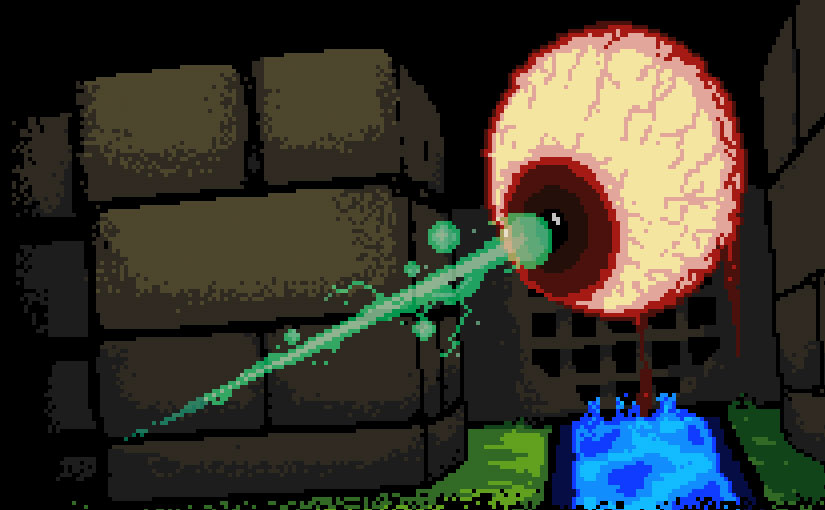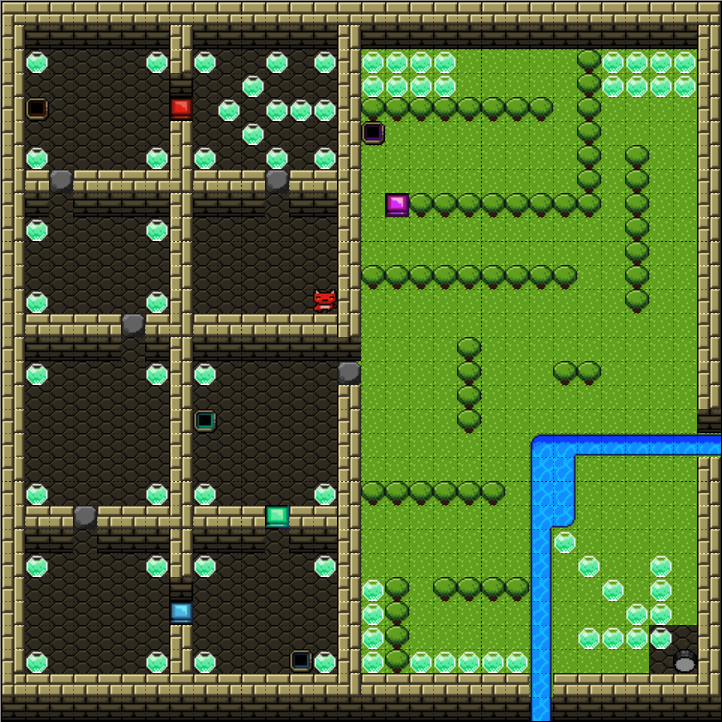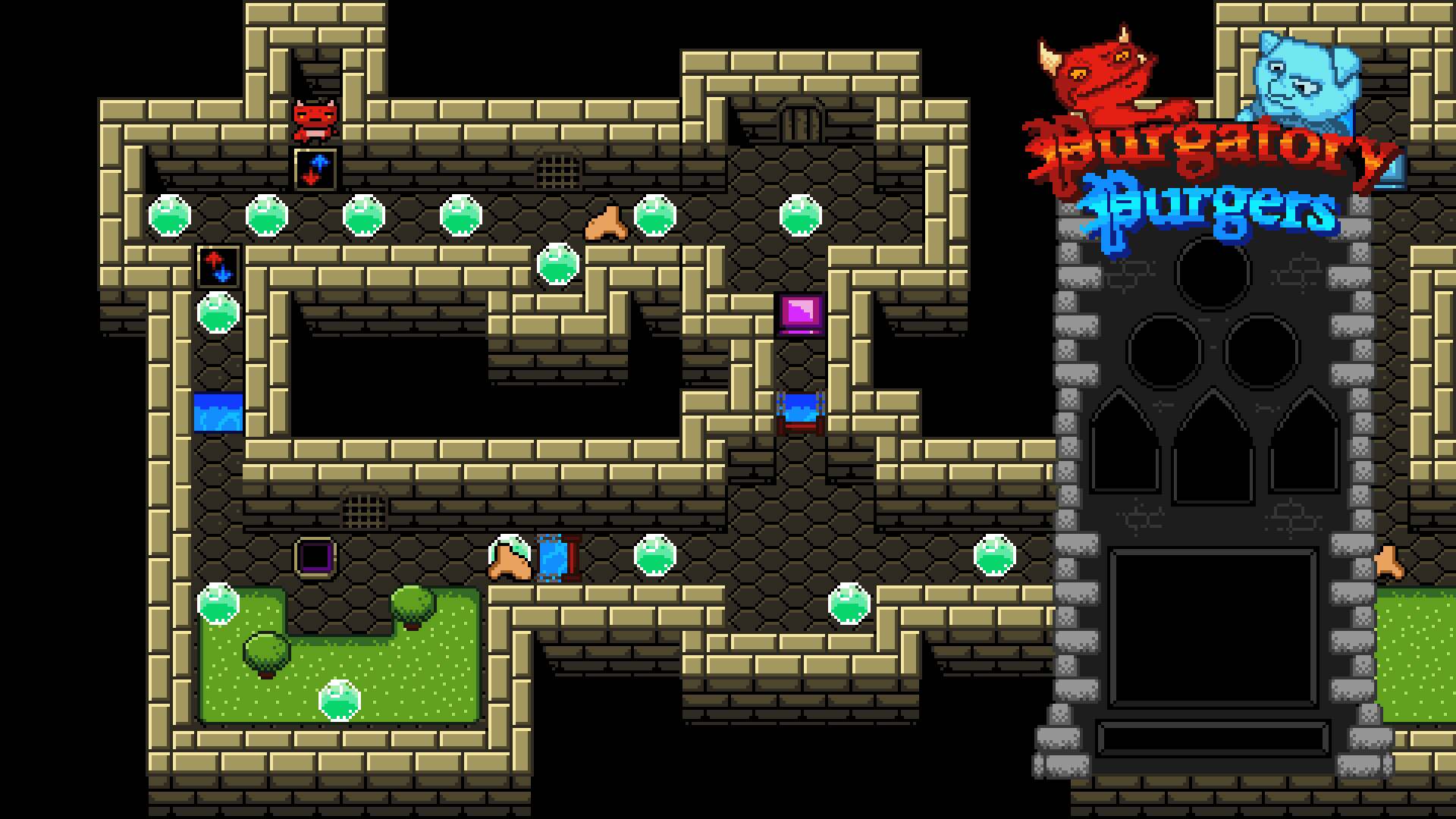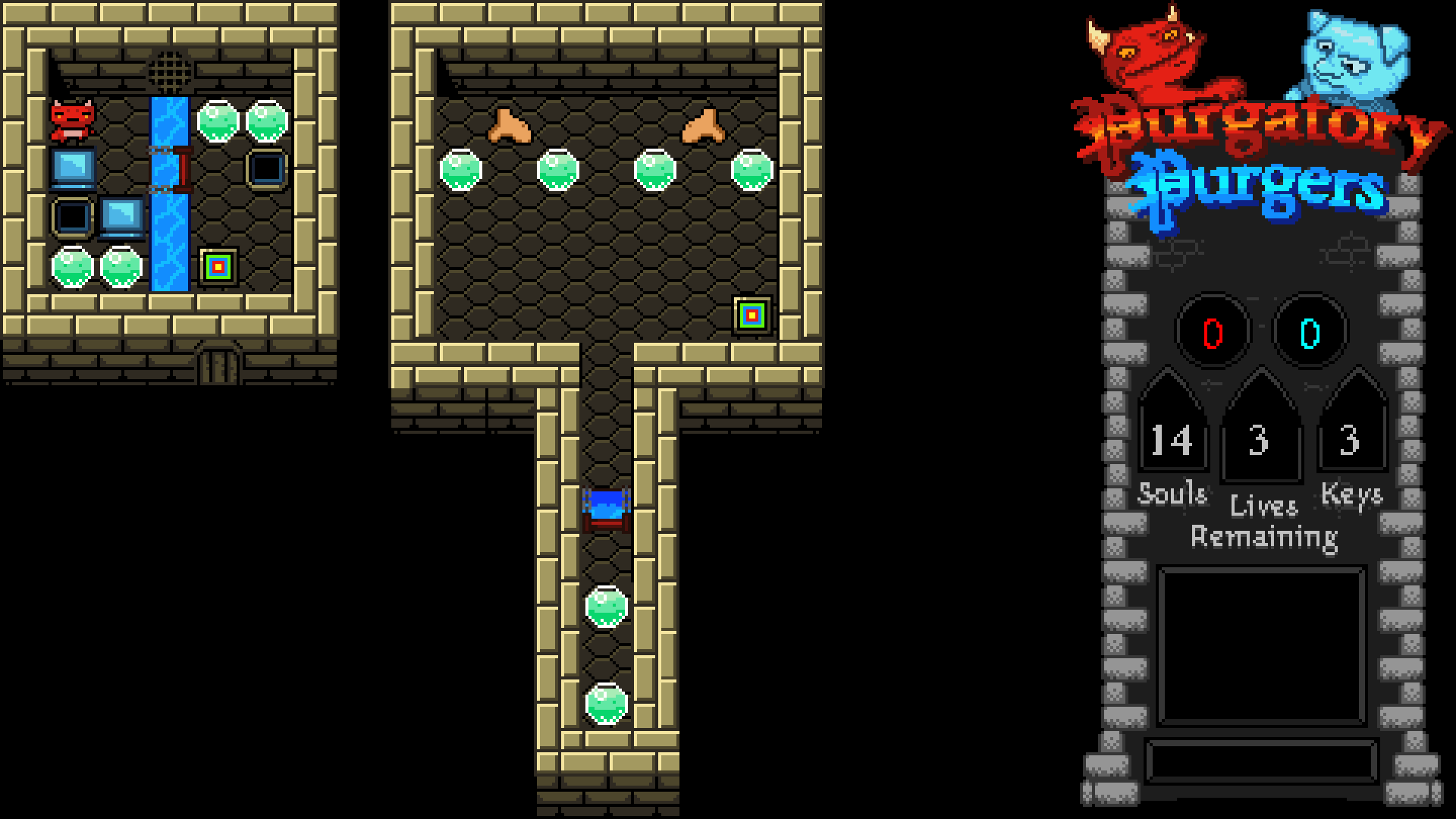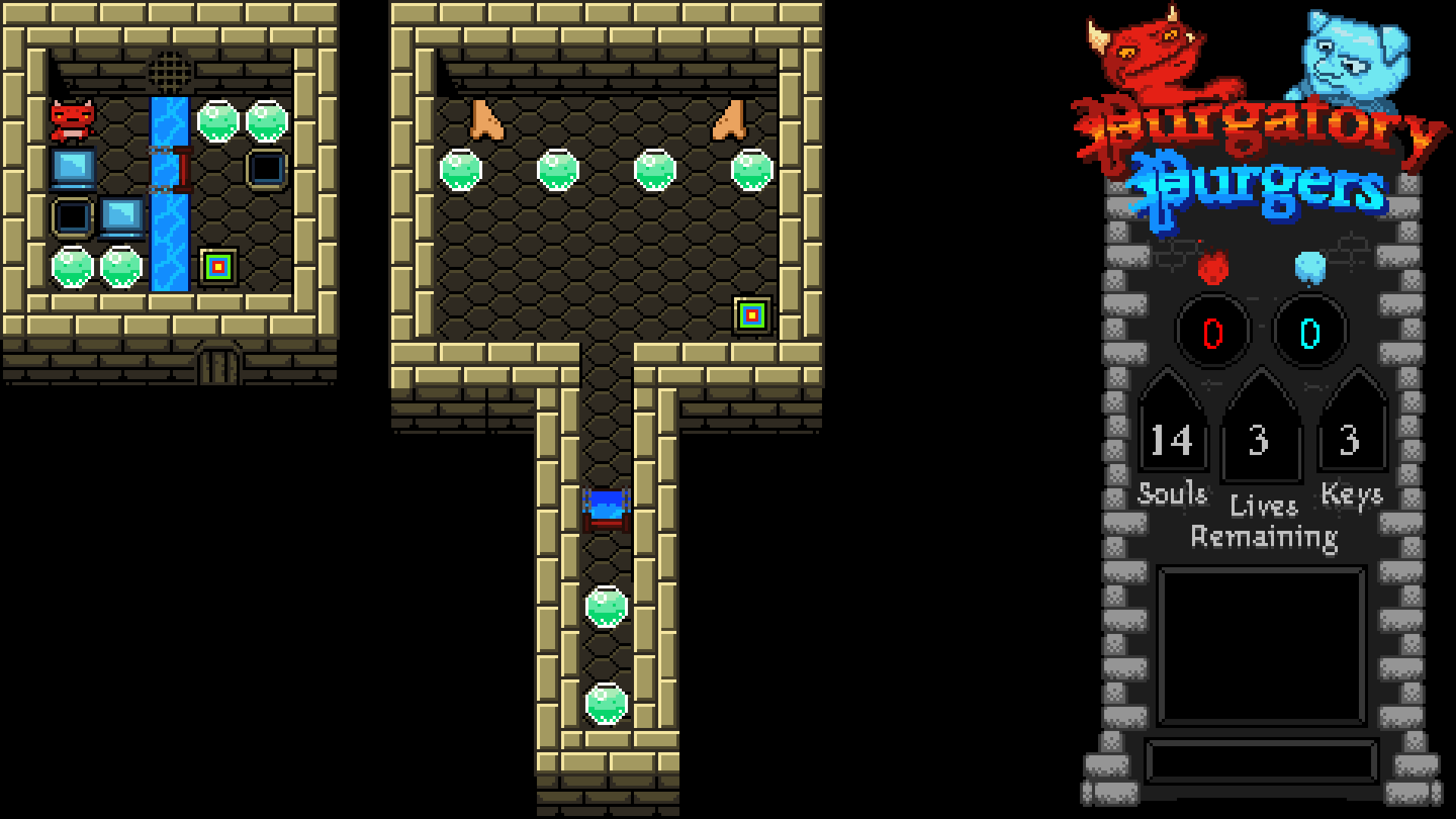How It Began
Back in September ’23, I announced that Eric and I were working together again after a 7-year hiatus. We’d agreed to start small, and after some initial discussion, Eric committed to taking on the roles of Game Designer and Level Designer. I would do the programming, artwork, sound effects, and music.
When we initially brainstormed game ideas, Eric fondly recalled the time he’d spent playing Chip’s Challenge on an old Windows 3.11 system and suggested we create something like that, starting with the core mechanic of pushing blocks into slots.
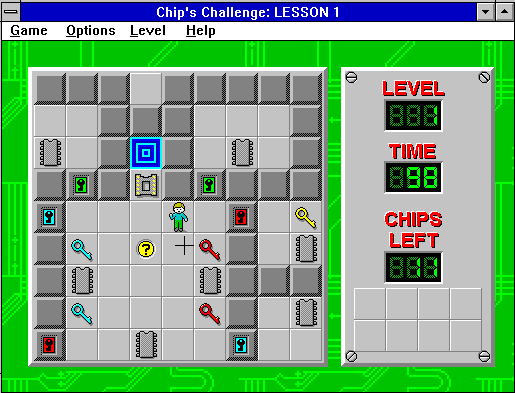
After some discussion, we settled on a Purgatory theme. Eric proposed two characters, an angel and a demon, each with their own unique abilities. The ‘demon’ (Imp) could push blocks, and the ‘angel’ (cherub) could fly over obstacles (e.g., water).
Eric didn’t remember any of the specifics of Chip’s Challenge, so I watched some gameplay videos and got a very rudimentary idea of how the game worked, focusing first on orthogonal, tile-based movement and then the “Sokoban” mechanic of pushing blocks into designated places.
I didn’t have a clear vision of the art style and started out with the intent of creating 32x32px tiles and character sprites. Here’s an early rendition of Bob:





Although he looks pretty good, the bigger the sprite, the more detailed it needs to be and the more time it would take to create. In addition to the player character, there are also the enemy sprites and tile sheets to consider.
Early sprite sheet designs were 32x32px tiles and single-height, meaning that the tops of the walls were on the same plane. This was simpler but didn’t look very good.
I eventually scrapped this all in favor of simpler, 16×16 tiles with fewer animation frames, akin to something you might see on the NES, albeit a slightly larger color palette (64 colors instead of 52, and support for alpha channel, which wasn’t something the NES could do).
In an effort to work in parallel, I’d asked Eric to block out level designs with primitive tiles that we could later replace as the finalized tile sheets were created.
This worked well initially, but as the tile sheet began to take shape, we encountered two issues that set us back:
- Eric’s designs were more complex than what my simple tile sheet was capable of, and absent the correct tiles, Eric would ‘wing it’ with the ones he had.
- The levels Eric created assumed features we hadn’t previously discussed. I was still working on the core mechanics and did not even have a working prototype of the basic gameplay yet.
In order to get this under control, I knew that I needed a playable game, and by mid-September ’23, I had one. I asked Eric to build a simple test level so that we could play the game. Here’s what that looked like:
The First Prototype
Having a working prototype can teach you a lot about your game. Is it fun? Does the core gameplay loop (i.e., the thing the player does in the game) work the way you expected? Is it complete?
I watched the Extra Credits video series on Making Your First Game. I’d watched dozens of GDC videos on game design. I knew that our focus needed to be getting the game to a playable prototype so that we could see what worked and what didn’t. I knew this – Eric did not…
How could he? He’s never made a game before. To him, game design meant thinking up cool ideas. That’s only natural, as that’s how a writer might approach the problem. A game designer needs to be able to articulate, in great detail, the logical systems that make up a game, the rules, for instance, and how to resolve problems you might encounter.
Take the angel for example. In our original discussions, we wanted the angel to be able to fly over water, so I focused on getting that mechanic working without thinking about why. In order to facilitate this, I had to create a test level and realized that simply moving to areas the demon couldn’t get to on his own wasn’t all that interesting – then it hit me…what about a bridge? What if the angel could lower bridges, allowing the demon and a block to reach places he couldn’t previously access?
This would not have occurred to me without actually playing the game.
Iterative Refinements
Initially, the movement system I created moved the character one space per key press. This worked fine on small levels, but with big, expansive ones like the test level he’d created, it was very fatiguing. To address this, we opted for continuous movement.
The more I played, the more I realized that half the fun of the game was exploration and collecting the souls, and the other half was the puzzles, but you had to have both. You can read more about Purgatory Purgers’ level design philosophy here.
As we talked through new features, I tried to corral Eric’s ideas into building on existing mechanics to create more value, using the example of secret rooms and passageways. The mechanic behind this reuses the water tile in a novel way. Eric suggested “hiding” the secret room, but there wasn’t an obvious way to do this due to the ‘skybox’ background we were using at the time.
By scrapping the sky tiles in favor of a plain black background, we could use an opaque black rectangle that’s destroyed on contact with the player to reveal the secret area. This was both easy to implement and highly reusable!
Creating the UI
We knew that we were going to need a UI for the game, so we discussed what should be in it, and Eric went to work on a simple mockup. Here’s what he came up with:
We initially discussed a scoring system in which the player earned points based on souls collected, gems slotted, completing a level, and number of moves made. Our game resolution was 480px wide by 270 pixels tall (1/4 scale of a target screen resolution of 1920×1080 in a 16:9 aspect ratio).
I found that even using the smallest font I could find (~5x5px per character), it would be impossible to cram all that information into such a small area. To get a sense of proportionality, I started with a simple shape and put it on the playfield:
As I began to play with designs, I arrived at something closer to the final one but found that placing it over the playable map didn’t look (or feel) good:
Moving it 16px to the right and adding a black background seemed to do the trick, but I also modified the camera (which was set to follow the player) to include a buffer equal to half the width of the level to keep the player centered on the screen – this would prevent the player from getting behind the black border (128px or approximately 8 tiles):
With the general layout done, I had to figure out how to populate the information it contained… More tweaking! I scraped the score (we didn’t have a solid design, and it felt a bit arbitrary), making more room for other elements. I also decided to stretch the UI a bit vertically to make more room for label text:
Finally, I added the animated ‘judged soul’ graphics, which brought it all together:
I noticed there wasn’t much room for the soul counters, so I incorporated some additional code to change the font once it reached the triple digits, but that came much later…
Mid-Development Hell
By October ’23, the core of the game was finished, save for creating a menu system, secret levels (and a system for accessing them), and additional levels to flesh everything out. Eric and I argued frequently.
We could not agree on a shared vision for the game, what a level should look like, or even the definition of Game Design!
For example, Eric spent what might have been several hours creating a very faithful rendition of the Pacman maze. While very well done (for what it is), it did not fit the theme of our game (not to mention possible copyright infringement).

Then there were the logistical obstacles… I had Eric create the levels in Tiled, and then I’d recreate them by hand in GMS2. This meticulous process took hours because each level comprised several tile layers (e.g., Walls and floors, decorations, water, object instances, etc.).
As the month came to a close, I was nearing my deadline for completing a very difficult certification Exam for work, so I put my development efforts on hold for the next 2 months to focus on that.
The Last Mile
At the end of December, I passed my Exam and was ready to resume work on Purgatory Purgers. Over the next few weeks, I started investigating ways we could improve our workflow and allow Eric to create levels directly in GameMaker.
My first thought was to try to implement source control, but not knowing what I was doing almost ended in disaster. I kept at it and was eventually able to work out how to import room resource files.
Although we’d overcome the technical hurdles, Eric wasn’t used to using GameMaker as all of his previous work was mocked up in Tiled, and then (re)created by me. Naturally, Eric did not create levels as quickly as he could in Tiled, nor were they of sufficient detail to meet the current standard. This isn’t to say that my levels were perfect either, and in fact, after playing through the game over and over again, I ended up redoing my first level and making significant cuts to other levels I felt were too bloated.
“…[sometimes], You must kill your darlings.” – William Faulkner
I came to the grim realization that Eric and I had fundamental disagreements that wouldn’t get resolved in this project. Eric had lots of ideas, but the concept of testing them and killing off the ones that didn’t make the cut was abhorrent to him. He placed a lot of value on his individual ideas as well as his ability to generate them. Still, he did not understand that the idea itself represented a tiny fraction of the overall effort required to execute it. Our imaginations are limitless; my time and abilities are finite. Sometimes, you must kill your darlings!
The only way forward was to create the remaining levels myself, along with the endings, menu system, and artwork, which I spent the next few weeks working on. By the middle of February ’24, I was done!
I took a few days to recover, then went back again to finalize it for release.
Publishing Purgatory
I originally intended to publish on GameJolt and Itch.io and advertise in the official GameMaker forums.
Unfortunately, I couldn’t edit the content on my GameJolt Developer page without encountering an “ERR_TOO_MANY_REDIRECTS” browser error. The platform is covered in ads, which suggests it’s either dead (or dying), so I decided to abandon it and move on to Itch.io.
Itch.io turned out to be a good choice. It is simple, easy to use, and straightforward. I captured a few screenshots and then spent about an hour creating a YouTube video to promote it. I spent a couple of days creating an old-school-style instruction manual and packaged it with the game.
Posts in the “Made with GameMaker” thread on the official forums require moderator approval. What confused me was that my post was initially visible to me and then disappeared later, leading me to believe it had been deleted. Thankfully, after reaching out to the moderators, I was assured that hadn’t happened, and a short while later, my post went live.
Reception and Payout
The only people who played and/or bought the game were a handful of personal friends, acquaintances, and a couple of kind folks from the Official GMS Forums. Jason D., John J., and others pointed out bugs and potential exploits, and I fixed what I could.
Overall, I spent about 480 hours on this project over 8 months. The proceeds were around ~4.2¢/hour (gross, 3¢/hour net).
Lessons Learned
Communication was a constant problem for Eric and me. Because we had different schedules, we could only speak in real time once per week. Between our weekly calls, I’d try to share my thoughts on progress with Eric through Discord messages. My DMs to him were too verbose, and his responses were too succinct.
It was difficult to discuss complex design topics this way. Often, a conversation would begin with, “Would it be possible to do [insert_feature_here]?”
I read somewhere about ‘Mu,’ the third answer to a Yes or No question, and it can be interpreted as “Your question cannot be answered because it depends on incorrect assumptions.”
A lot of what Eric was asking about sounded simple and straightforward, but it usually lacked sufficient elaboration to explain exactly how it would fit into the game. When I asked Eric if the juice was worth the squeeze, I was trying to convey to him whether he wanted me to pause work on implementing core game features for the one-off feature he was asking about.
From my perspective, Eric’s question was lazy and uninformed, and from Eric’s perspective, I was dismissive and impersonal. While we eventually talked it out, it took a lot of heated arguments to get to that point.
For me, Purgatory Purgers was never intended to be my magnum opus; instead, it was one more step towards learning how to be a game developer. Eric had more faith in the project than I did, but as far as I can see, that faith was more wishful thinking than anything else. Would I be upset if Purgatory Purgers was a runaway success? Absolutely not, but I also understand that some games, charming though they are, don’t have mass appeal and never will.
I guess the biggest takeaway is that my next game ought to be more memeable :).
